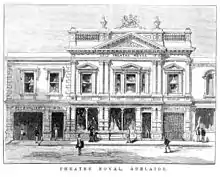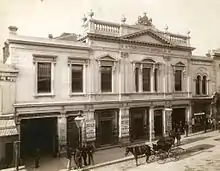Theatre Royal, Adelaide
The Theatre Royal on Hindley Street, Adelaide was a significant venue in the history of the stage in South Australia.
History

The first "Theatre Royal" in Adelaide was a small venue above the Adelaide Tavern in Franklin Street, managed by Mr. Bonnar and was opened in May 1838. The first production staged there was Mountaineers, or, Love and Madness (Colman). Bonnar was succeeded as manager by Sampson Marshall. This was eclipsed in 1841 by the opening of the Queen's Theatre on Gilles Arcade, off Currie Street, and the old theatre was remodelled as a Commercial Exchange. In December 1850 The Royal Victoria Theatre opened, also on Gilles Arcade, with Coppin and Lazar joint managers.
In December 1865 a prospectus was issued in Adelaide for a Theatre Royal company to take over White's Assembly Rooms and the adjacent Clarence Hotel,[2] alternatively to purchase a vacant site and erect a new building.[3] By December 1867 plans had been prepared for a new structure to be added to the rear of Peter Cummings & Son's drapery store at 21 Hindley Street, Leonard Voullaire's at 23 (then was the financially troubled Paull & Meredith's wine bar 1868–1870), and Mrs Bament's at 27.[4] Paull & Meredith had a wine bar.[5] T. English was chosen as supervising architect and W. Lines the builder.[6] The proprietors were John Temple Sagar, Samuel Lazar and J. M. Wendt.[7] The foundation stone was laid by owner of the property H. R. Fuller on 8 January 1868, and the first performance held on 13 April 1868 (Easter Monday) was All that Glitters is not Gold by J. M. Morton.[8] Edgar Chapman became owner of the property shortly after; it remained in his family for some time.
The first lessee and director was George Coppin of Coppin, Harwood and Hennings, with stage manager J. R. Greville (1834–1894), a noted comedian.[9]
Samuel Lazar was lessee and manager from 1870, for a time in partnership with one Reuben Mills, suspended while his liquidity was being sorted out, then sole lessee from 1871.[10] James Allison joined him as partner in 1873, became sole lessee around 1876.
In October 1876 Edgar Chapman purchased the Theatre Royal, its hotel and the adjoining shops for £11,000, and lost no time in appointing George R. Johnson architect for a complete rebuild of the theatre.[11] The rebuilt house was opened on 25 March 1878 with an address written by Ebenezer Ward, followed by the opera Giroflé-Girofla with Emily Soldene, Minna Fischer and Clara Vesey.[12] These first few years were the heyday of musical theatre.[13] In 1883 external fire stairs were erected in response to demands from the City Council.[14]
In January 1885 Arthur Chapman, a brother of the owner, joined George Rignold and James Allison as co-lessees; Chapman being the local representative.[15] In December Rignold and Allison withdrew from the partnership, leaving Chapman as sole trustee,[16] as well as acting as managing the property for the ailing Edgar Chapman, and then for his estate. He continued in both roles April 1886, when Williamson, Garner, & Musgrove took over the lease, and on 1887 appointed Wybert Reeve as manager. Around 1889 Reeve became sole lessee of the theatre. On 19 October 1896 he hosted the first public demonstration in South Australia of moving pictures, the projector being a cinématographe Lumière.[17]
Wybert Reeve retired from management in 1900, and sold the lease to F. H. Pollock, who managed the theatre capably until forced by illness to take on Herbert Percy Myers (1879–1927), his wife's nephew, as manager. Pollock died in November 1908, and his wife continued to run it in partnership with Myers. The theatre was further enlarged and updated in 1914.[18] Myers purchased the lease in December 1921,[19] and in 1920 purchased the property from the Chapman estate. He subsequently sold half to Sir George Tallis, who sold half of that to the Tait family business. Myers' half share was inherited by his widow, and in January 1954 Tallis sold his interest to the J. C. Williamson organization.[20]
The department store Miller Anderson & Co. took over the properties between the Theatre Royal and Gresham Street, and erected a five-storey building. They demolished the theatre in 1962 to build an "exceptionally ugly"[21] multi-level car park.
See also
The Theatre Royal, Adelaide, ran more-or-less continuously in Hindley Street from 1868 to 1961. Some other similarly named Australian theatres were:
- Theatre Royal, Melbourne 1855–1933 on Bourke Street
- Theatre Royal, Sydney 1827–1840; 1875–1971 on Castlereagh Street; 1976– on King Street
- Theatre Royal, Hobart 1837–Now
References
- Peel street would be just past the left of the photo. The department store Miller Anderson & Co. took over the properties to the east (right in the photo) towards Gresham Street
- "Advertising". South Australian Register. XXIX (5966). South Australia. 14 December 1865. p. 1. Retrieved 11 May 2017 – via National Library of Australia.
- "Proposed Theatre Company". South Australian Register. XXIX (5969). South Australia. 18 December 1865. p. 3. Retrieved 11 May 2017 – via National Library of Australia.
- "Miscellaneous". South Australian Register. XXXI (6598). South Australia. 28 December 1867. p. 7. Retrieved 11 May 2017 – via National Library of Australia.
- "An Historic Playhouse I." The Register (Adelaide). LXXIX (20, 971). South Australia. 28 January 1914. p. 6. Retrieved 15 May 2017 – via National Library of Australia.
- "Theatre Royal". Adelaide Observer. XXV (1369). South Australia. 28 December 1867. p. 5. Retrieved 11 May 2017 – via National Library of Australia.
- "General News". The Express and Telegraph. V (1, 234). South Australia. 9 January 1868. p. 3. Retrieved 13 May 2017 – via National Library of Australia.
- "Theatre Royal". South Australian Register. XXXII (6688). South Australia. 14 April 1868. p. 2. Retrieved 11 May 2017 – via National Library of Australia.
- "Dramatic Notes". Evening Journal (Adelaide). XXVI (7359). South Australia. 19 May 1894. p. 5. Retrieved 11 May 2017 – via National Library of Australia.
- "Heads of Intelligence". The Express and Telegraph. VIII (2, 358). South Australia. 9 September 1871. p. 2. Retrieved 13 May 2017 – via National Library of Australia.
- "A New Theatre for Adelaide". South Australian Register. XLII (9606). South Australia. 28 August 1877. p. 6. Retrieved 19 May 2017 – via National Library of Australia. This article includes considerable detail of the new design.
- "An Historic Playhouse II". The Register (Adelaide). LXXIX (20, 972). South Australia. 29 January 1914. p. 9. Retrieved 12 May 2017 – via National Library of Australia.
- "An Historic Playhouse III". The Register (Adelaide). LXXIX (20, 974). South Australia. 31 January 1914. p. 18. Retrieved 12 May 2017 – via National Library of Australia. These three articles give a useful roll-call of notable shows and performers to the outbreak of WWI.
- "Theatre Royal Improvements". The South Australian Advertiser. XXV (7674). South Australia. 24 May 1883. p. 7. Retrieved 17 May 2017 – via National Library of Australia.
- "Another Change". The South Australian Advertiser. XXVII (8182). South Australia. 8 January 1885. p. 5. Retrieved 13 May 2017 – via National Library of Australia.
- "Entertainments". Adelaide Observer. XLII (2307). South Australia. 19 December 1885. p. 26. Retrieved 17 May 2017 – via National Library of Australia.
- Dylan Walker. Adelaide's Silent Nights. National Film & Sound Archive. ISBN 0-642-25238-6.
- "Our Playhouse". Daily Herald. 4 (1215). South Australia. 13 February 1914. p. 5. Retrieved 11 May 2017 – via National Library of Australia.
- "Enterprising Theatrical Manager". The Mail (Adelaide). 10 (502). South Australia. 24 December 1921. p. 1. Retrieved 12 May 2017 – via National Library of Australia.
- "Theatre Royal May Be Sold". The Advertiser (Adelaide). 96 (29, 751). South Australia. 19 February 1954. p. 1. Retrieved 15 May 2017 – via National Library of Australia.
- "Adelaide City Heritage: Theatre Royal". Adelaide City Council. Retrieved 18 May 2017.
